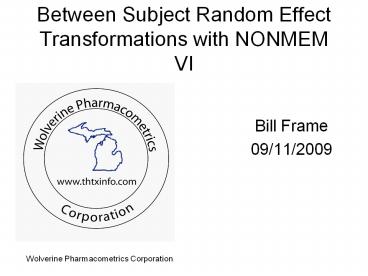Between Subject Random Effect Transformations with NONMEM VI - PowerPoint PPT Presentation
Title:
Between Subject Random Effect Transformations with NONMEM VI
Description:
Between Subject Random Effect ( ) Transformations. Why bother with ... John - Draper (1980): Wolverine Pharmacometrics Corporation. An Example, Finally! ... – PowerPoint PPT presentation
Number of Views:125
Avg rating:3.0/5.0
Title: Between Subject Random Effect Transformations with NONMEM VI
1
Between Subject Random Effect Transformations
with NONMEMVI
- Bill Frame
- 09/11/2009
2
Between Subject Random Effect (?) Transformations.
- Why bother with transformations?
- What is a transformation?
- Examples and Brief History.
- Implementation and examples in NONMEM (V or VI)
3
Why Bother with Transformations?
Variance stabilization (Workshop 7). NONMEM
assumes that ? N(0,?) A better statistical fit
to the data? Perhaps simulations can be improved
upon, as opposed to a model with no eta
transformation?
4
- Q What is an ETA transformation?
- A A one to one function that maps ETA to a new
random effect ET, as a function of a fixed effect
parameter (?). - Q What are desirable properties of such a
transformation? - Invertible, this means one to one.
- Domain Real line, the same as ETA.
- Differentiable with respect to argument and
parameter, more of a theoretical issue than a
practical one. - Null value for lambda is not on boundary of
parameter space.
5
Examples and Brief History
Transformations can be applied to 1. Statistics
i.e. Fishers Z transformation for the Pearson
product moment correlation coefficient (?).
Z ½loge((1?)/(1-?)) 2.
The response (YDV) Change Y to ZY1/2 if E(Y) ?
Var(Y) and model Z, this is sometimes done for
Poisson data.
6
Examples and Brief History
3. Predictors (i.e. SHOE) Consider the simple
linear (in the random effects) mixed model with
the usual assumptions Y THETA(1)
THETA(2)SHOETHETA(3) ETA(1) EPS(1) 4.
Random effects (?) The rest of workshop 6.
7
What is Skewness?
A number? This is pulled from the S-Plus 6.1 help
API. If y x - mean(x), then the "moment" method
computes the skewness value as
mean(y3)/mean(y2)1.5
8
What is Kurtosis?
A number? This is pulled from the S-Plus 6.1 help
API. If y x - mean(x), then the "moment"
method computes the kurtosis value as
mean(y4)/mean(y2)2 - 3.
9
Transformations for Skewness Removal
Power Family
Box - Cox (1964)
Manly (1976)
10
Kurtosis Removal
John - Draper (1980)
11
An Example, Finally!
Back to our second example PopPK! C1.TXT
DATA1.TXT
12
Much Data/Subject Conditional Estimation
PK KATHETA(1)EXP(ETA(1))
ET2(EXP(ETA(2)THETA(4))-1)/THETA(4) THETA(4)
LAMBDA KTHETA(2)EXP(ET2)
S2THETA(3)WT THETA (0,1) KA (0,.12)
K (0,.4) VD (.5) LAMBDA TRANSFORM
PARAMETER OMEGA .25 INTER-SUBJECT VARIATION
KA OMEGA BLOCK(1) .05 INTER-SUBJECT VARIATION
K ERROR YF(1EPS(1)) SIGMA .013
PROPORTIONAL ERROR ESTIMATION MAXEVALS9000
PRINT1 METHOD1 INTERACTION
13
Results with nmv or nm6?
C6.TXT Drop in MOF of 16 points. ? Estimate
0.9































